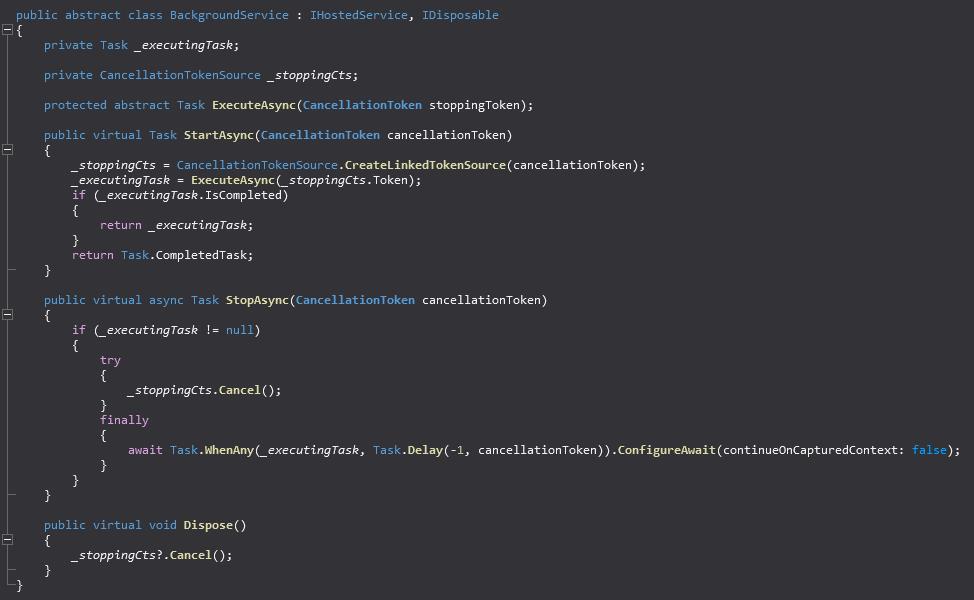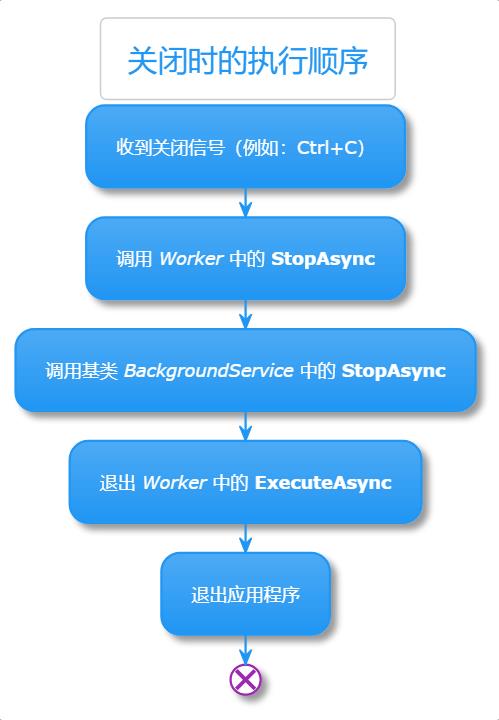.NET Worker Service 如何优雅退出
Posted 『技术译站』
tags:
篇首语:本文由小常识网(cha138.com)小编为大家整理,主要介绍了.NET Worker Service 如何优雅退出相关的知识,希望对你有一定的参考价值。
上一篇文章中我们了解了 .NET Worker Service 的入门知识[1],今天我们接着介绍一下如何优雅地关闭和退出 Worker Service。
Worker 类
从上一篇文章中,我们已经知道了 Worker Service 模板为我们提供三个开箱即用的核心文件,其中 Worker 类是继承自抽象基类 BackgroundService 的,而 BackgroundService 实现了 IHostedService 接口。最终 Worker 类会被注册为托管服务,我们处理任务的核心代码就是写在 Worker 类中的。所以,我们需要重点了解一下 Worker 及其基类。
先来看看它的基类 BackgroundService :

基类 BackgroundService 中有三个可重写的方法,可以让我们绑定到应用程序的生命周期中:
- 抽象方法
ExecuteAsync:作为应用程序主要入口点的方法。如果此方法退出,则应用程序将关闭。我们必须在 Worker 中实现它。 - 虚方法
StartAsync:在应用程序启动时调用。如果需要,可以重写此方法,它可用于在服务启动时一次性地设置资源;当然,也可以忽略它。 - 虚方法
StopAsync:在应用程序关闭时调用。如果需要,可以重写此方法,在关闭时释放资源和销毁对象;当然,也可以忽略它。
默认情况下 Worker 只重写必要的抽象方法 ExecuteAsync。
新建一个 Worker Service 项目
我们来新建一个 Worker Service,使用 Task.Delay 来模拟关闭前必须完成的一些操作,看看是否可以通过简单地在 ExecuteAsync 中 Delay 来模拟实现优雅关闭。
需要用到的开发工具:
- Visual Studio Code:https://code.visualstudio.com/
- 最新的 .NET SDK:https://dotnet.microsoft.com/download
安装好以上工具后,在终端中运行以下命令,创建一个 Worker Service 项目:
dotnet new Worker -n "MyService"
创建好 Worker Service 后,在 Visual Studio Code 中打开应用程序,然后构建并运行一下,以确保一切正常:
dotnet build
dotnet run
按 CTRL+C 键关闭服务,服务会立即退出,默认情况下 Worker Service 的关闭就是这么直接!在很多场景(比如内存中的队列)中,这不是我们想要的结果,有时我们不得不在服务关闭前完成一些必要的资源回收或事务处理。
我们看一下 Worker 类的代码,会看到它只重写了基类 BackgroundService 中的抽象方法 ExecuteAsync:
protected override async Task ExecuteAsync(CancellationToken stoppingToken)
{
while (!stoppingToken.IsCancellationRequested)
{
_logger.LogInformation("Worker running at: {time}", DateTimeOffset.Now);
await Task.Delay(1000, stoppingToken);
}
}
我们尝试修改一下此方法,退出前做一些业务处理:
protected override async Task ExecuteAsync(CancellationToken stoppingToken)
{
while (!stoppingToken.IsCancellationRequested)
{
_logger.LogInformation("Worker running at: {time}", DateTimeOffset.Now);
// await Task.Delay(1000, stoppingToken);
await Task.Delay(1000);
}
_logger.LogInformation("等待退出 {time}", DateTimeOffset.Now);
Task.Delay(60_000).Wait(); //模拟退出前需要完成的工作
_logger.LogInformation("退出 {time}", DateTimeOffset.Now);
}
然后测试一下,看它是不是会像我们预期的那样先等待 60 秒再关闭。
dotnet build
dotnet run
按 CTRL+C 键关闭服务,我们会发现,它在输出 “等待退出” 后,并没有等待 60 秒并输出 “退出” 之后再关闭,而是很快便退出了。这就像我们熟悉的控制台应用程序,默认情况下,在我们点了右上角的关闭按钮或者按下 CTRL+C 键时,会直接关闭一样。
Worker Service 优雅退出
那么,怎么才能实现优雅退出呢?
方法其实很简单,那就是将 IHostApplicationLifetime 注入到我们的服务中,然后在应用程序停止时手动调用 IHostApplicationLifetime 的 StopApplication 方法来关闭应用程序。
修改 Worker 的构造函数,注入 IHostApplicationLifetime:
private readonly IHostApplicationLifetime _hostApplicationLifetime;
private readonly ILogger<Worker> _logger;
public Worker(IHostApplicationLifetime hostApplicationLifetime, ILogger<Worker> logger)
{
_hostApplicationLifetime = hostApplicationLifetime;
_logger = logger;
}
然后在 ExecuteAsync 中,处理完退出前必须完成的业务逻辑后,手动调用 IHostApplicationLifetime 的 StopApplication 方法,下面是丰富过的 ExecuteAsync 代码:
protected override async Task ExecuteAsync(CancellationToken stoppingToken)
{
try
{
// 这里实现实际的业务逻辑
while (!stoppingToken.IsCancellationRequested)
{
try
{
_logger.LogInformation("Worker running at: {time}", DateTimeOffset.Now);
await SomeMethodThatDoesTheWork(stoppingToken);
}
catch (Exception ex)
{
_logger.LogError(ex, "Global exception occurred. Will resume in a moment.");
}
await Task.Delay(TimeSpan.FromSeconds(5), stoppingToken);
}
}
finally
{
_logger.LogWarning("Exiting application...");
GetOffWork(stoppingToken); //关闭前需要完成的工作
_hostApplicationLifetime.StopApplication(); //手动调用 StopApplication
}
}
private async Task SomeMethodThatDoesTheWork(CancellationToken cancellationToken)
{
_logger.LogInformation("我爱工作,埋头苦干ing……");
await Task.CompletedTask;
}
/// <summary>
/// 关闭前需要完成的工作
/// </summary>
private void GetOffWork(CancellationToken cancellationToken)
{
_logger.LogInformation("啊,糟糕,有一个紧急 bug 需要下班前完成!!!");
_logger.LogInformation("啊啊啊,我爱加班,我要再干 20 秒,Wait 1 ");
Task.Delay(TimeSpan.FromSeconds(20)).Wait();
_logger.LogInformation("啊啊啊啊啊啊,我爱加班,我要再干 1 分钟,Wait 2 ");
Task.Delay(TimeSpan.FromMinutes(1)).Wait();
_logger.LogInformation("啊哈哈哈哈哈,终于好了,下班走人!");
}
此时,再次 dotnet run 运行服务,然后按 CTRL+C 键关闭服务,您会发现关闭前需要完成的工作 GetOffWork 运行完成后才会退出服务了。
至此,我们已经实现了 Worker Service 的优雅退出。
StartAsync 和 StopAsync
为了更进一步了解 Worker Service,我们再来丰富一下我们的代码,重写基类 BackgroundService 的 StartAsync 和 StopAsync 方法:
public class Worker : BackgroundService
{
private bool _isStopping = false; //是否正在停止工作
private readonly IHostApplicationLifetime _hostApplicationLifetime;
private readonly ILogger<Worker> _logger;
public Worker(IHostApplicationLifetime hostApplicationLifetime, ILogger<Worker> logger)
{
_hostApplicationLifetime = hostApplicationLifetime;
_logger = logger;
}
public override Task StartAsync(CancellationToken cancellationToken)
{
_logger.LogInformation("上班了,又是精神抖擞的一天,output from StartAsync");
return base.StartAsync(cancellationToken);
}
protected override async Task ExecuteAsync(CancellationToken stoppingToken)
{
try
{
// 这里实现实际的业务逻辑
while (!stoppingToken.IsCancellationRequested)
{
try
{
_logger.LogInformation("Worker running at: {time}", DateTimeOffset.Now);
await SomeMethodThatDoesTheWork(stoppingToken);
}
catch (Exception ex)
{
_logger.LogError(ex, "Global exception occurred. Will resume in a moment.");
}
await Task.Delay(TimeSpan.FromSeconds(5), stoppingToken);
}
}
finally
{
_logger.LogWarning("Exiting application...");
GetOffWork(stoppingToken); //关闭前需要完成的工作
_hostApplicationLifetime.StopApplication(); //手动调用 StopApplication
}
}
private async Task SomeMethodThatDoesTheWork(CancellationToken cancellationToken)
{
if (_isStopping)
_logger.LogInformation("假装还在埋头苦干ing…… 其实我去洗杯子了");
else
_logger.LogInformation("我爱工作,埋头苦干ing……");
await Task.CompletedTask;
}
/// <summary>
/// 关闭前需要完成的工作
/// </summary>
private void GetOffWork(CancellationToken cancellationToken)
{
_logger.LogInformation("啊,糟糕,有一个紧急 bug 需要下班前完成!!!");
_logger.LogInformation("啊啊啊,我爱加班,我要再干 20 秒,Wait 1 ");
Task.Delay(TimeSpan.FromSeconds(20)).Wait();
_logger.LogInformation("啊啊啊啊啊啊,我爱加班,我要再干 1 分钟,Wait 2 ");
Task.Delay(TimeSpan.FromMinutes(1)).Wait();
_logger.LogInformation("啊哈哈哈哈哈,终于好了,下班走人!");
}
public override Task StopAsync(CancellationToken cancellationToken)
{
_logger.LogInformation("太好了,下班时间到了,output from StopAsync at: {time}", DateTimeOffset.Now);
_isStopping = true;
_logger.LogInformation("去洗洗茶杯先……", DateTimeOffset.Now);
Task.Delay(30_000).Wait();
_logger.LogInformation("茶杯洗好了。", DateTimeOffset.Now);
_logger.LogInformation("下班喽 ^_^", DateTimeOffset.Now);
return base.StopAsync(cancellationToken);
}
}
重新运行一下
dotnet build
dotnet run
然后按 CTRL+C 键关闭服务,看看运行结果是什么?
我们可以观察到在 Worker Service 启动和关闭时,基类 BackgroundService 中可重写的三个方法的运行顺序分别如下图所示:


总结
在本文中,我通过一个实例介绍了如何优雅退出 Worker Service 的相关知识。
Worker Service 本质上仍是一个控制台应用程序,执行一个作业。但它不仅可以作为控制台应用程序直接运行,也可以使用 sc.exe 实用工具安装为 Windows 服务,还可以部署到 linux 机器上作为后台进程运行。以后有时间我会介绍更多关于 Worker Service 的知识。
作者 : 技术译民
出品 : 技术译站
https://mp.weixin.qq.com/s/ujGkb5oaXq3lqX_g_eQ3_g .NET Worker Service 入门介绍 ↩︎
https://github.com/ITTranslate/WorkerServiceGracefullyShutdown 源码下载 ↩︎
以上是关于.NET Worker Service 如何优雅退出的主要内容,如果未能解决你的问题,请参考以下文章